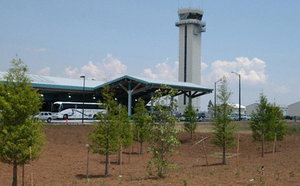Trending
Q & A with Kevin Johnson, vice president at
Firm spearheading one of the largest developments in America

The Northwest Florida Beaches International Airport
The St. Joe Company, the second-largest landowner in Florida, is developing the West Bay Sector, a 75,000-acre mixed-use development in the Panama City region, one of the largest mixed-use developments in the United States, in an area that has never seen this level, or scale, of development. The area’s success will be driven by the new Northwest Florida Beaches International Airport, for which St. Joe donated 4,000 acres of land. It marks the first international airport in the country built in the last 15 years. Historically, this area of northwestern Florida has been centered on aerospace and defense, something St. Joe wants to capitalize on. The Real Deal talked to Kevin Johnson, vice president at St. Joe, about the future of the West Bay Sector, what it means to northwest Florida and what it means for the Florida economy.
How is the real estate market in northern Florida?
If we’re just talking about residential growth, then this area has challenges just like the rest of the state of Florida. We see trends suggesting there is an upside to this dynamic, and we want to be in a position to take full advantage of it when it occurs. One of the things we’re doing is having opened an international airport, to allow for more potential customers to get in this market quicker.
What is the state of the West Bay Sector?
The catalytic event was and still is the opening of the Northwest Florida Beaches International Airport. Obviously we are a partner in that because of our land donation — 4,000 acres — but the West Bay Sector is 76,000 acres. We’re talking about a build-out of 37 million square feet of built space [including] 27,000 residential units. Now it’s a matter of phasing, timing and marketing response.
What has development been like in this region?
The history of this area has been one of a laid-back, tourist-driven economy. For a lot of years, that was the hallmark of how growth occurred here. Primarily, organizations have tried to preserve the area as opposed to mass-develop it. Now, the plan is about balancing tourism and tourism-driven economics with preserving the pristine nature of the area. If the lands on that area on the Gulf had been available for mass development, I dare say it might look like Miami today. We’ve conformed [to] the way development has occurred in this market. But now, it’s led us to think about how to deal with the lands we own that are off the coast — and West Bay is a response to that. We want to still maintain the nature of our coasts, and balance that with a commercial and industrial development platform.
What motivated your decision to begin development of the West Bay Sector?
We recognize that this area has tremendous potential. We want to assist in driving that potential to a reality that we can embrace. We have a military and defense economic platform here, and that is something we have paid attention to. We want industrial sites that are unencumbered, that can allow for growth and expansion of those companies that would come to this market to support the military-industrial complex we have here.




